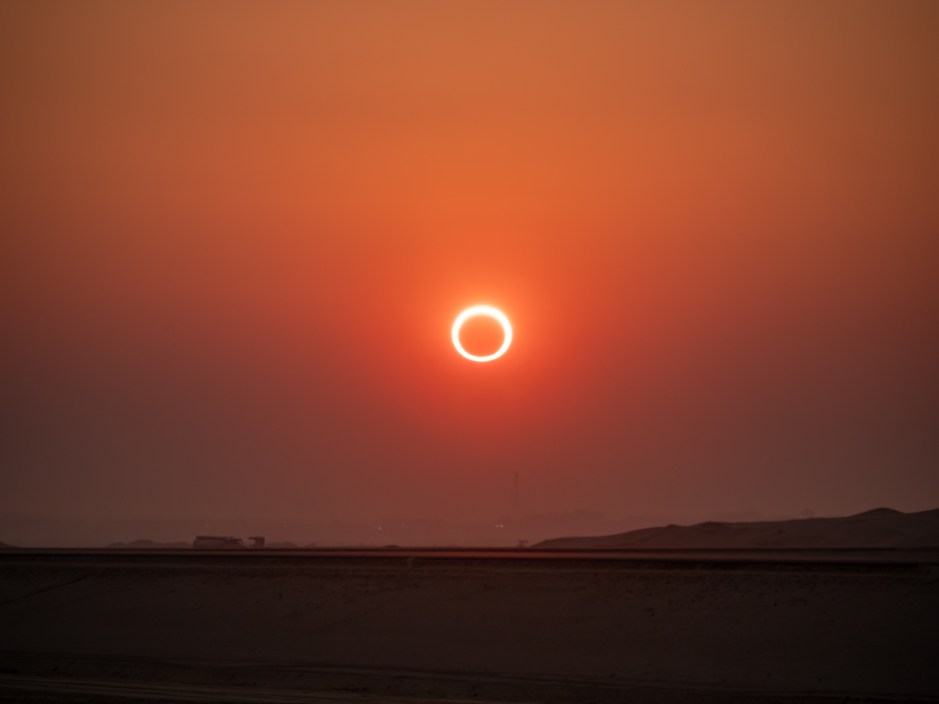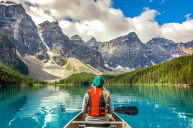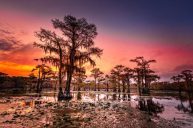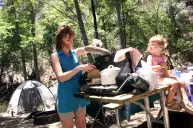Something called a "ring of fire" eclipse is coming—and yes, this stargazing event is as cool as it sounds. This type of eclipse happens when the moon appears smaller than the sun behind it, so instead of total darkness, a brilliant red ring of light surrounds the moon.
On the morning of October 14, 2023, this annular, or ring-shaped, solar eclipse—when the moon passes between the sun and the earth—will cross the North American sky and be visible from Oregon to Texas. The eclipse will last about five minutes long, with 15 minutes of partial eclipse before and after. Read on for the goods on how and where to best view this astronomical event.
Why Is a Ring of Fire Eclipse so Special?
The last ring of fire eclipse happened on a similar path across the western United States over a decade ago, on May 20, 2012. However, the apparent size of the moon in 2012 was larger than it will be this year, covering more of the sun. This time around, the moon will only cover about 90% of the sun, leaving a more prominent "ring of fire." In other words, it will be a rare sight—and people are already making travel plans to see it!
You can find prime viewing for the eclipse in seven states total: Oregon, Nevada, Utah, New Mexico, and Texas will have the widest option of places to view, while in Colorado and Arizona, only a small amount of the state will see it.
Why Nevada Offers Perfect "Ring of Fire" Viewing
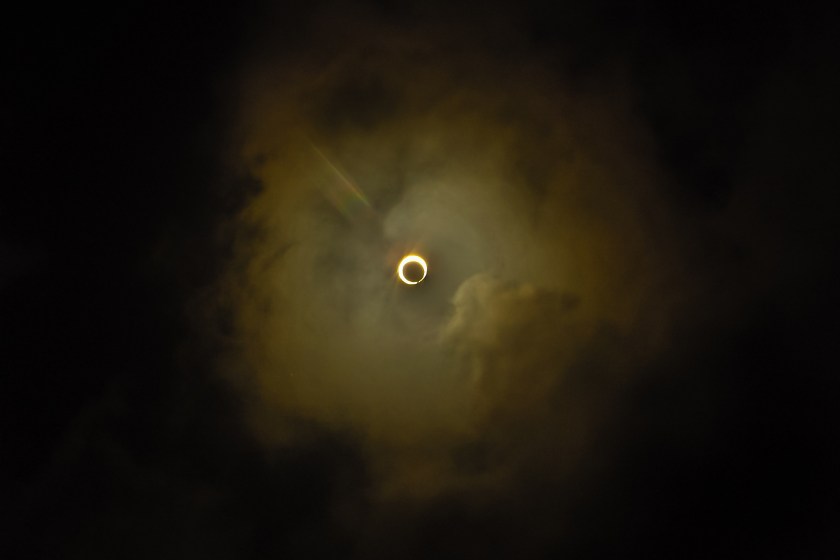
Getty Images, PMLouro
Nevada may not be as popular a tourist destination as other states on that list, it's one of the best places to watch the "ring of fire." That's because it has a lower average cloud coverage during this time of day and year than Oregon, Utah, and Texas, so you can expect a spectacular view. (Another option is Roswell, New Mexico, which claims the lowest chance of cloud coverage.)
There are other perks, too. The state is home to some of the quietest land and astounding beauty—a whopping 85.9 percent of the state is public land, second only to Alaska's staggering 95.8 percent.
The state of Nevada also offers many free places to camp without a permit, including a dark sky sanctuary, a national park, ghost town, hot spring, and more. Plus, let's be honest, you probably won't be saddled between armies of families with crying children and unruly dogs all fighting for the same view as you might at Crater Lake or Arches National Park. And did we mention free and no timed entry or permitting necessary?
If you aren't willing to look past your favored towering conifers to the less forested Silver State, move along. But if you're curious and want to have a wild adventure during the 2023 "ring of fire" eclipse, read on for the underrated Nevada spots that will deliver a unique experience.
READ MORE: The 9 Best State Parks in Nevada, Ranked
Where to See the Ring of Fire Eclipse
1. Black Rock Desert
The Black Rock Desert is home to the notorious Burning Man festival, but it makes a fantastic place to camp in early October. The desert, which is on BLM land, is a dried lakebed and one of the largest, flattest surfaces on earth. It's so vast and desolate, in fact, that this is where the world land speed record of 763.035 miles per hour was set in October 1997. It's said that on a normal day, you can put a brick on the accelerator of your car and climb onto the roof without the worry of running into anything.
The vastness of Black Rock makes this a great place to camp for the eclipse. Because it's 70 miles long and 20 miles wide in some parts, you're very likely find yourself an amazing primitive campsite away from all others.
The Friends of the Black Rock (FBR) recommend dispersed campsites along the western edge of the playa, where campers can find "bays" that offer privacy. However, campers may also head for the middle of the dried lake bed. FBR also advises: "The best campsites are found, not made. Use existing campsites where possible to prevent unnecessary impacts to the desert resources."
READ MORE: Dispersed Camping Allows You to Stay in the Wilderness for Free
2. Soldier Meadows Hot Springs
There are over 300 natural hot springs across Nevada, but only one notable spring is in the path of the eclipse. Soldier Meadows is very remote, oftentimes called Nevada's most secluded spring.
It's located in the northwestern Black Rock Desert and can be accessed by Country Road 34 N, 60 miles north of Gerlach. The road leading to the springs is not for the faint of heart, though. It can be rough and may take two hours to drive. However, once you arrive, you'll be able to relax in absolute quiet.
The springs are on BLM land but you can find semi-primitive sites that have preexisting fire rings. Try your luck by arriving early to snag the BLM-managed cabin that's free and available on a first-come, first-served basis. It provides basic amenities such as a wood-burning stove and pit toilet. You won't find any potable water or services here, so be sure to pack in (and out) everything you need.
Nevada's hot springs have been enjoyed for thousands of years, from the land's first inhabitants—tribes like the Washoe or Paiute—to the miners who settled here in the late 1800s. Hot springs provide a host of health benefits to users, from pain relief to muscle relaxation to improved cardiovascular health. If Soldier Meadows feels like too far a trek, other Nevada hot springs across the northern part of the state each provide their own beauty and relaxation.
3. Great Basin National Park
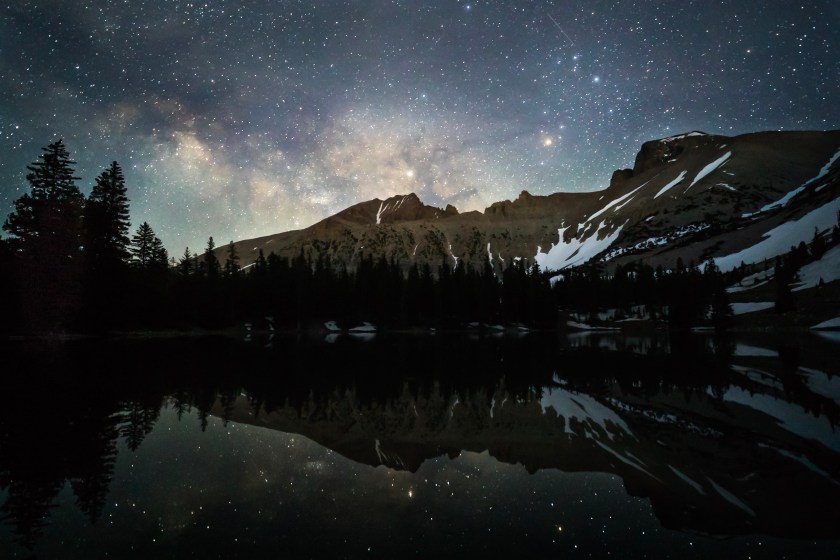
Getty Images, Elizabeth M. Ruggiero
Eclipse aside, Great Basin National Park is a Nevada must-see. Within its boundaries is the state's second-highest peak—the 13,167-foot Wheeler Peak—an incredible cave system, ancient bristlecone pines, and relatively few visitors. The park is also free to enter and to backpack within.
While the eclipse will be incredible from anywhere in the park, the most scenic place to watch may just be from the ancient bristlecone forest. Take the 3.7-mile, out-and-back Bristlecone Pine Glacier Trail to get there.
Camping isn't allowed in the bristlecone pine forest, but you can camp at one of the park's designated campsites (four of which require reservations via Recreation.gov, and all require a nightly fee), or choose another trail to backpack in. The Baker Lake Trail is a beautiful 11-mile, out-and-back trail, making for an unforgettable overnight trip.
Though it's free to backpack in the park, a registration permit is mandatory for the Baker Creek trailhead. There are a few places other within the park where camping isn't allowed. This includes within the Wheeler Peak vicinity or in bristlecone pine groves, but also in the Lexington Arch day-use areas and on the Osceola Ditch Trail. Fires are prohibited above 10,000 feet as well.
4. Ely, Nevada
For those looking for a more social experience, the town of Ely, dissected by Route 50, will be the center for the Nevada Ring of Fire Eclipse Festival. The town is situated on the eastern side of the state, about an hour west of Great Basin National Park and about five hours east of Reno.
The festival officially starts on October 11 and offers outings until October 16. Don't miss the Aliens UFO Event at the Ely White Pine Public Museum on the 13th or the Ring of Fire 5K before the eclipse on the 14th. The Punkin Chunkin' renaissance fair also begins with the eclipse, where "pumpkins will fly, knights will battle and the skies will darken."
The festival recommends a few camping options that require reservations, including glamping experiences. However, dispersed camping can be found in the Ward Mountain area just southwest of town. To access, take Highway 6 west of Ely to NF-440 and drive 2.5 miles to find the dispersed camping area. Located in a valley surrounded by mountains, this campsite allows you to enjoy the spirit and beauty of the outdoors with the convenience of town.
5. Massacre Rim Dark Sky Sanctuary
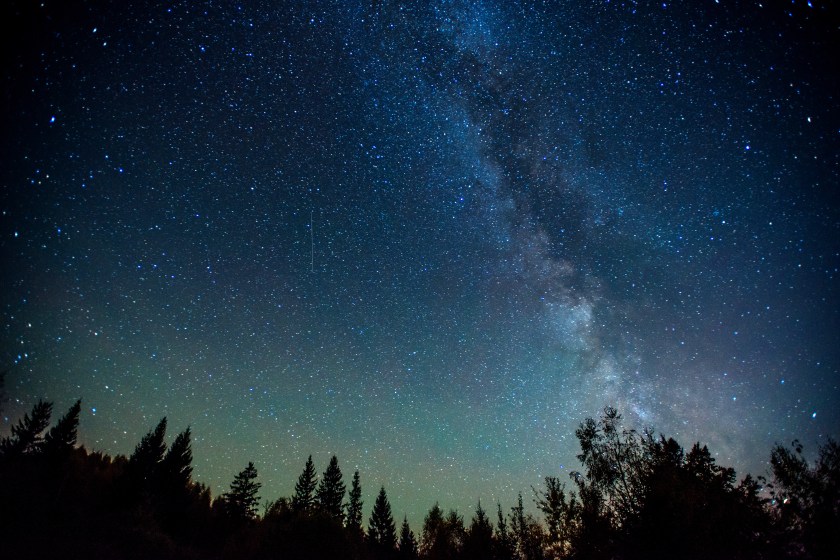
Getty Images, standret
Though the name sounds formidable, there's no gory past or lingering spirits here, though you may encounter a few free-range cows or coyotes. In fact, Massacre Rim Dark Sky Sanctuary is quite peaceful. The name comes from the second wave of migratory miners making their way across the state who mistook stone markers along the trail as gravesites.
Massacre Rim is one of only 17 Dark Sky Sanctuaries in the world, awarded this designation because its remote location makes it one of the darkest places on earth. So dark, in fact, that astrologists discovered new parts of the Milky Way from here. It goes without saying that an overnight stay here rewards with breathtaking stargazing and this will be an incredible spot to watch the eclipse.
There are several ways to get to this northwestern corner of the state. From Reno, it is about a 4-and-a-half hour drive north via Highway 395. Head's up: There are zero facilities around the sanctuary and the nearest town is Cedarville, across the border in California.
6. Ruby Mountains
The Ruby Mountains are stunning, glacier-carved peaks that some refer to as the Swiss Alps of Nevada. The highest peak in the range is 11,388 feet, and home to a range of wildlife, including bighorn sheep, and beautiful alpine lakes. The closest town to the Rubies is Elko, which can be reached by a 20-minute drive down Lamoille Canyon National Scenic Byway (State Route 227).
The best way to enjoy this mountain range is to backpack in. The 43-mile Ruby Crest Trail takes hikers through some of the best the range has to offer, though you may opt to take one of the many other trails suitable for day hiking or single overnights.
For a weekend hike, try the 11.3-mile, round-trip Castle Lake Loop, which includes seven lakes. (One AllTrails reviewer says that this is "the best hike in Nevada.") Campers can stay at Castle Lake, which requires no reservations or permits for overnight trips. After your hike here, be sure to stop in Elko for hand pies at B.J. Bull Bakery, where they serve sweet and savory (try the beef and potato).
7. Midas Ghost Town
Nevada boasts more than 600 ghost towns. Because of the state's rich mining—thusly named the Silver State—transient miner erected many towns all over and abandoned them as the claims ran dry. Ghost towns are also an awesome place to watch the eclipse. As the light dims across the partial ruins of these abandoned towns, an apocalyptic, creepy, and perfect-for-Instagram scene takes place.
If this is your first Nevada ghost town camping experience, Midas is a great choice because it's a "living" ghost town, meaning a small population of 12 to 20 people still call it home. The notable Bighorn Saloon welcomes travelers with a bite to eat, a cold beer, and advice for camping spots in the area.
Don't let the working bar fool you, though. This is still a remote location with limited cell service and limited services, so be sure to pack all the food, water, and extras you will need to get here. (If you'd like more information, contact Dana at the Friends of Midas.) To get here from I-80, take the Golconda exit just east of Winnemucca, then continue northeast on State Route 789 North/Midas Road for 43 miles. The last 30 miles or so are dirt road, so be prepared!
Other notable ghost towns to check out within the range include Unionville (where Mark Twain once tried to prospect), Metropolis, Cherry Creek, and Belmont Mill Ghost Town. Whenever visiting ghost towns, be sure to respect all posted private property signs and double-check property lines with the OnX app to find public land to set up camp.
Tips for Traveling to Nevada for the "Ring of Fire" Eclipse
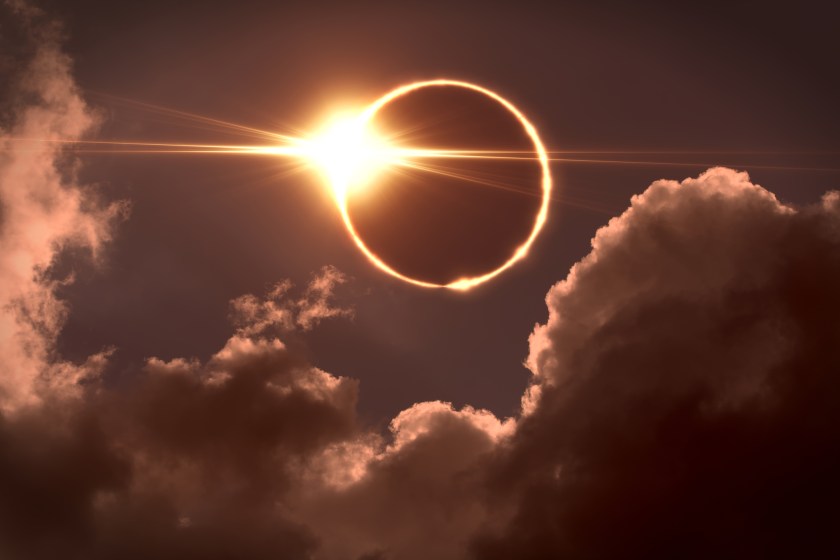
Getty Images, Pitris
1. Buy Solar Eclipse Glasses
First thing's first: During an annular eclipse, it's never safe to look directly at the sun without specialized eye protection designed for solar viewing. Sunglasses (no matter how dark), telescopes, and camera lenses are not adequate protection for your eyes during an eclipse, according to the American Astronomical Society.
Luckily, you can buy affordable solar eclipse glasses that comply with safety standards to prepare for your viewing experience.
2. Check the Weather
Be sure to check the weather while planning your trip, not only to ensure a cloud- or rain-free experience but to ensure that the roads will stay dry if traveling across one of Nevada's many dirt or gravel roads. Never drive on a dried lake bed, like Black Rock playa, after a rain.
3. Be Cautious of Snakes
Yes, there are rattlesnakes in Nevada, and they like to be out in the sun when temps are in the low 70s to mid 80s—the expected daytime temps for this time of year. Rattlers tend to shy away from people when they can, but curious dogs wandering through the sagebrush sometimes put their noses right in the way of a snake. Be cautious with your pets and keep them safe!
4. Take Extra Safety Precautions
Nevada is remote, and places that aren't directly on I-80 or Highway 50 are often accessed via dirt roads, have limited services, and don't have cell service. Carry plenty of extra water, a spare tire, and possibly your satellite communicator.
5. Remember to 'Leave No Trace'
People tend to think of desert-filled Nevada as "nothing," which might make it more tempting to leave behind trash and unburied poop. However, Nevada is home to many endemic species of plants and animals and, despite its hardy appearance, has fragile ecosystems. As with anyone, it's essential to practice Leave No Trace: Plan ahead and prepare, travel and camp on durable surfaces, dispose of waste properly, leave what you find, minimize campfire impacts, respect wildlife, and be considerate of other visitors.
READ MORE: 6 Stargazing Festivals Worth Planning Your National Park Trips Around
